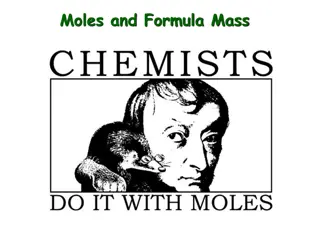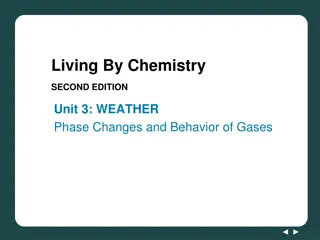Understanding Gas Laws: Boyle's, Charles', Gay-Lussac's, and Avogadro's Laws
Gas laws such as Boyle's Law, Charles' Law, Gay-Lussac's Law, and Avogadro's Law govern the behavior of gases under different conditions. Boyle's Law relates pressure and volume at constant temperature, Charles' Law relates volume and temperature at constant pressure, Gay-Lussac's Law relates pressure and temperature at constant volume, and Avogadro's Law relates volume and moles at constant temperature and pressure. Understanding these laws helps in predicting the changes in gas properties in various conditions.
Download Presentation

Please find below an Image/Link to download the presentation.
The content on the website is provided AS IS for your information and personal use only. It may not be sold, licensed, or shared on other websites without obtaining consent from the author. Download presentation by click this link. If you encounter any issues during the download, it is possible that the publisher has removed the file from their server.
E N D
Presentation Transcript
The Gas Laws 1.Boyle s Law 2.Charles Law 3.Gay-Lussac s Law 4.Avogadro s Law
Boyles Law Boyle s Law at constant temperature, the volume of the gas increases as the pressure decreases. The volume of the gas decreases and the pressure increases. V P V o l u m e L P1V1 = P2V2 If you squeeze a gas sample, you make its volume smaller. Pressure (kPa)
Now . . . a container where the volume can change (syringe) Moveable piston Same temperature Volume is 100 mL at 25 C Volume is 50 mL at 25 C In which system is the pressure higher? (Which has the greater number of collisions with the walls and each other?)
Charles Law Charles Law at a constant pressure, the volume of a gas increases as the temperature of the gas increases and the volume decreases when the temperature decreases. V1 T1 V2 T2 = increase AKE increase the speed of the particles the walls of a flexible container expand think of hot air balloons! V o l u m e L Temperature (K)
A B Steel cylinder (2L) contains 500 molecules of O2 at 800 K Steel cylinder (2L) contains 500 molecules of O2 at 400 K 1. In which system do the O2 molecules have the highest average kinetic energy? 2. In which system will the particles collide with the container walls with the greatest force? 3. In which system is the pressure higher? B B B
Gay-Lussacs Law Gay-Lussac s Law the pressure of a gas is directly proportional to its absolute temperature at a constant volume. P1 T1 P2 T2 Pressure (atm) = Temperature (K)
To remember how these work. . . P T V Think Public Tele Vision
To remember which constants go with which law . . . Boyle s Law Temperature is constant BLT Cheese Pizza Charles Law Pressure is constant Green Veggies Gay-Lussac s Law Volume is constant
Combined Gas Law P1V1 T1 P2V2 T2 = The equation is found on Table T. Note that all temperatures must be in Kelvin!
Units used to describe gas samples: Volume Liter (L) Milliliter (mL) 1000 mL = 1L Temperature Kelvin ONLY Pressure Atmosphere (atm) Kilopascale (kPa) 1 atm = 101.3 kPa 1 atm = 760 mm Hg 1 atm = 760 torr
Avogadros Law Avogadro s Law equal volumes of gases at the same temperature and pressure contain equal numbers of molecules. H2 O2 CO2 1 mole of ANY gas takes up a volume of 22.4 L at STP.
YouTube - Chemistry Music Video 7: Rock Me Avogadro
Ideal Gases Gases whose behavior can be predicted by the kinetic molecular theory are called ideal, or perfect, gases. No gases are truly ideal because no gas totally obeys all of the gas laws. An ideal gas is an imaginary gas that is perfect and does follow everything perfectly.
Ideal Gases, continued An ideal gas does not condense to a liquid at low temperatures An ideal gas does not have forces of attraction or repulsion between particles An ideal gas is composed of particles that have no volume.
Real Gas Vs. Ideal Gas A real gas is most like an ideal gas when the real gas is at a low pressure and a high temperature. The gases that act most like ideal gases are the small mass ones hydrogen and helium.
Diffusion movement of particles from areas of high concentrations to areas of low concentration. Gases diffuse and mix with other gases very rapidly due to their rapid motion. (Think ammonia, tuna or skunk smell.) It eventually reaches equilibrium and the mixture is homogeneous. Entropy is the randomness of particles. Effusion the passage of gas under pressure through a small opening. (Gases effuse through a hole in your tire!)
Two More Laws!! Graham s Law Particles of low molar mass travel faster than heavier particles. Hydrogen effuses 4 times faster than oxygen. Dalton s Law of Partial Pressure - In a mixture of gases, each gas exerts a certain pressure as if it were alone. The pressure of each one of these gases is called the partial pressure. The total pressure of a mixture of gases is the sum of all of the partial pressures. Ptotal = PA + PB + PC
Example: A closed cylinder contains 3L of He, 1L of H2 and the total pressure in the system is 800 torr. What is the partial pressure of the He? Ptotal = PA + PB + PC 3L + 1L = 4L AND 4L = 800 torr 4L = 800 torr 4 4 1L = 200 torr 1L H2 200 torr 3L He 600 torr 4L gas 800 torr























